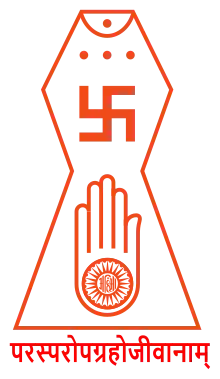Samantabhadra (Jain monk)
Samantabhadra was a Digambara acharya (head of the monastic order) who lived about the later part of the second century CE.[1][2] He was a proponent of the Jaina doctrine of Anekantavada. The Ratnakaranda śrāvakācāra is the most popular work of Samantabhadra. Samantabhadra lived after Umaswami but before Pujyapada.
Samantabhadra | |
|---|---|
 | |
| Personal | |
| Born | 2nd century CE |
| Religion | Jainism |
| Sect | Digambara |
| Notable work(s) | Ratnakaranda śrāvakācāra, Āpta-mīmāṁsā, Jinaśatakam |
| Part of a series on |
| Jainism |
|---|
 |
Life
Samantabhadra is said to have lived from 150 CE to 250 CE. He was from southern India during the time of Chola dynasty. He was a poet, logician, eulogist and an accomplished linguist.[3] He is credited with spreading Jainism in southern India.[4]
Samantabhadra, in his early stage of asceticism, was attacked with a disease known as bhasmaka (the condition of insatiable hunger).[5] As, digambara monks don't eat more than once in a day, he endured great pain. Ultimately, he sought the permission of his preceptor to undertake the vow of Sallekhana.[6] The preceptor denied the permission and asked him to leave monasticism and get the disease cured.[5] After getting cured he again joined the monastic order and became a great Jain Acharya.[7]
Thought
Samantabhadra affirmed Kundakunda's theory of the two nayas - vyavahāranaya (‘mundane') and niścayanaya (ultimate, omniscient). He argued however that the mundane view is not false, but is only a relative form of knowledge mediated by language and concepts, while the ultimate view is an immediate form of direct knowledge.[8] Samantabhadra also developed further the Jain theory of syādvāda.
Works

Jain texts authored by Acharya Samantabhadra are:[9]
- Ratnakaranda śrāvakācāra[10] (150 verses)- The Ratnakaranda śrāvakācāra discusses the conduct of a Śrāvaka (Jain laity) in detail.[4]
- Gandhahastimahabhasya, a monumental commentary on the Tattvartha Sutra. The Gandhahaslimahahhasya, with the exception of its Manglacharana (salutation to the deity), is extant now.[11] The Manglacharana is known as the 'Devagama stotra' or Āpta-mīmāṁsā.[4][12]
- Āpta-mīmāṁsā- A treatise of 114 verses, it discusses the Jaina concept of omniscience and the attributes of the Omniscient.[4][13]
- Svayambhustotra (fifth century CE)[14] - A Sanskrit adoration of The Twenty-four Tirthankaras[15] - 143 verses.[4] It was later translated by Dhyanatray (1676-1726) in Agra.[14]
- Yuktyanusasana- Sixty-four verses in praise of Tirthankara Vardhamāna Mahāvīra[4]
- Jinasatakam (Stutividyā)[16](116 verses)- Poetical work written in Sanskrit in praise of twenty-four Jinas.[17]
- Tattvanusasana
- Vijayadhavala tika
Praise
Jinasena, in his celebrated work, Ādi purāṇa praises the Samantabhadra as[18]
Acharya Samantrabhadra’s glory reigned supreme among all poets, scholars, disputants, and preachers; he was like a jewel on their heads.
References
Citations
- Gokulchandra Jain 2015, p. 82.
- Champat Rai Jain 1917, p. iv.
- Natubhai Shah 2004, p. 48.
- Natubhai Shah 2004, p. 49.
- Vijay K. Jain 2015, p. xviii.
- Long 2009, p. 110.
- Vijay K. Jain 2015, p. xx.
- Long 2009, p. 130.
- Gokulchandra Jain 2015, p. 84.
- Samantabhadra, Ācārya (1 July 2006), Ratnakaranda Shravakacara, Hindi Granth Karyalay, ISBN 9788188769049
- Champat Rai Jain 1917, p. v.
- Ghoshal 2002, p. 7.
- Vijay K. Jain 2015, p. xvii.
- Orsini & Schofield 1981, p. 89.
- Vijay K. Jain 2015, p. xi.
- Samantabhadrasvāmī (1969), Kevalajñānapraśnacūḍāmaṇi
- Gokulchandra Jain 2015, p. 92.
- Vijay K. Jain 2015, p. xv.
Sources
- Ghoshal, Saratchandra (2002), Āpta-mīmāṁsā of Āchārya Samantabhadra, Bharatiya Jnanpith, ISBN 9788126307241
- Jain, Vijay K. (2015), Acarya Samantabhadra's Svayambhustotra: Adoration of The Twenty-four Tirthankara, Vikalp Printers, ISBN 978-81-903639-7-6,
 This article incorporates text from this source, which is in the public domain.
This article incorporates text from this source, which is in the public domain. - Jain, Gokulchandra (2015), Samantabhadrabhāratī (1st ed.), Budhānā, Muzaffarnagar (U.P.): Achārya Shāntisāgar Chani Smriti Granthmala, ISBN 978-81-90468879
- Jain, Champat Rai (1917), The Ratna Karanda Sravakachara, The Central Jaina Publishing House,
 This article incorporates text from this source, which is in the public domain.
This article incorporates text from this source, which is in the public domain. - Long, Jeffery D. (2009), Jainism: An Introduction, I.B. Tauris, ISBN 978-1-84511-625-5
- Orsini, Francesca; Schofield, Katherine Butler, eds. (1981), Tellings and Texts: Music, Literature and Performance in North India, Open Book Publishers, ISBN 978-1-78374-105-2
- Shah, Natubhai (2004) [First published in 1998], Jainism: The World of Conquerors, vol. I, Motilal Banarsidass, ISBN 81-208-1938-1